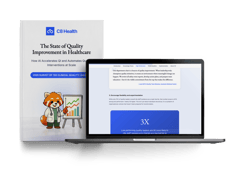
The Role of Risk Management in Healthcare Quality
Healthcare is such an intricate industry that identifying and assessing potential risks ahead of time is paramount. Whether you're a registered nurse or a surgeon, understanding the strategies employed in risk management can offer useful insights into the complex web of healthcare quality and patient safety. Let's explore the key strategies and methodologies employed to identify and assess potential risks in healthcare and why they're so important.
Meet the Expert
Ido Zamberg M.D. is a board-certified physician (General Internal Medicine and Anesthesia), currently a Fellow at the Division of Experimental Medicine, McGill University Health Center, Montreal, Canada
» Want to standardize care within your organization? Check out C8 Health.
Identifying and Assessing Risks in Healthcare
While risk management in hospitals on a large scale is a specialized field, we can glean valuable insights from healthcare practitioners who assess and anticipate risks daily. Consider the realm of anesthesia, often regarded as one of the riskiest professions globally. Anesthetists work with patients who might be in optimal health one moment and entirely dependent on their expertise the next. The stakes are exceptionally high. For example, an expectant mother enters the hospital to deliver her baby, and anesthesia becomes a crucial part of the process.
To identify potential risks, healthcare professionals employ systematic processes whether documented or not. These tools help assess any potential hazards associated with a specific surgery or procedure.
- The evaluation occurs during the preoperative phase, either during pre-anesthesia consultation or in emergency cases when the patient is first encountered.
- Defined questions and checklists ensure that everything is covered before any medical procedure commences and can significantly enhance perioperative care.
- A surgical timeout, a practice inspired by aviation safety practices, also occurs. In it, all the stakeholders related to anesthesia, surgery, and perioperative care assess potential risks associated with the procedure.
Basically, identifying and assessing potential risks in healthcare demands a systematic approach to every procedure. Understanding roles in the surgical pathway, from preoperative to postoperative care, is crucial. This meticulous preparation allows anesthesiologists to navigate complex scenarios with confidence.
Mitigating Risks in Healthcare
Identifying potential risks makes it easier for healthcare professionals to follow systemic mitigation protocols. Imagine a scenario where a patient has a known allergy to an essential antibiotic. In this case, early identification of the allergy allows doctors to develop a proactive action plan. This plan may include specific steps to address the risk if it becomes a reality. Such measures could involve administering steroids, modifying post-operative care procedures, or closely monitoring the patient to effectively minimize the potential risk.
The core of risk mitigation lies in evidence-based guidelines and protocols. These guidelines offer a structured approach to identifying and addressing anticipated risks. Each step is meticulously planned to minimize potential harm. Moreover, collaboration among healthcare professionals is indispensable in successful risk management, ensuring every detail is accounted for.
» Want to make the most of your team's protocols? Organize them with C8 Health.
The Role of Interdisciplinary Teamwork
Interdisciplinary teamwork is the linchpin of healthcare quality and patient safety. In a busy operating room (OR), every member has a critical role assigned based on their expertise. For example:
- Surgeon: The surgeon is the primary medical practitioner responsible for performing the surgical procedure.
- Anesthesiologist: Anesthesiologists are responsible for administering anesthesia to the patient and monitoring the patient's vital signs throughout the surgery, ensuring the patient remains stable and pain-free.
- Nurses: Nurses play a crucial role in the operating room. This includes the circulating nurse (manages the OR environment) and the scrub nurse (maintains the sterility of the surgical field).
- Surgical Technologist: Also known as a scrub tech or operating room technician, this healthcare professional assists the surgical team by preparing the operating room, sterilizing instruments, and ensuring that everything needed for the surgery is in place.
- Surgical Assistant: A surgical assistant may work alongside the surgeon to provide additional support during the procedure.
- Biomedical Equipment Technician (BMET): BMETs ensure that all medical equipment and devices in the OR are functioning correctly and safely.
- Anesthesia Technician: An anesthesia technician assists the anesthesia team by setting up and maintaining anesthesia equipment, including monitors and machines.
- Operating Room Manager: This administrative role ensures the smooth flow of cases, schedules surgical procedures, and manages the overall operation of the OR suite.
Each health professional has specific toolsets, roles, and experience. It's essential to ensure each professional knows their role.
Today, simulations in healthcare emphasize multidisciplinary approaches. Effective communication and clear role definitions are central to these simulations, reflecting the lessons learned from aviation and similar fields. Coordinated care enhances patient outcomes and elevates overall healthcare quality.
Knowledge management can help improve collaboration between roles and departments, but many healthcare organizations struggle with it. Our latest white paper provides an in-depth analysis of the topic.
» Coordinate care with our C8 Health platform.
The Future of Risk Management in Healthcare
As we peer into the future, risk management in healthcare is poised for transformation. Patient safety and quality are gaining prominence, driven in part by the shift towards value-based care. This model compels healthcare providers to adhere to specific protocols and guidelines, demanding efficiency without compromising safety.
Furthermore, the healthcare landscape is gradually recognizing the need for concrete pathways and protocols, and technology is the driving force behind this evolution. Though challenges persist, there's a growing awareness that safety and quality measures are not mere inconveniences but essential components of effective care. Evidence-based workflows will likely become ubiquitous, aiding physicians and clinicians in implementing protocols anytime, anywhere.
In the coming years, we anticipate a healthcare ecosystem where safety, quality, and efficiency coexist harmoniously, thanks to the transformative role of technology. This integration of technology is ultimately ensuring the best possible care for patients and helping healthcare providers navigate the complex landscape of risk management in the modern healthcare industry.


